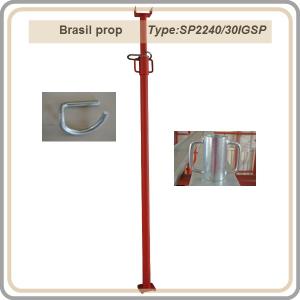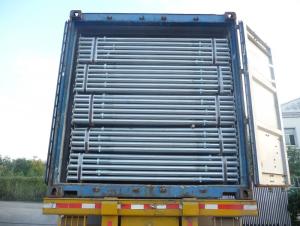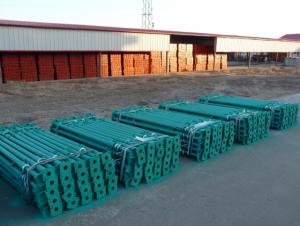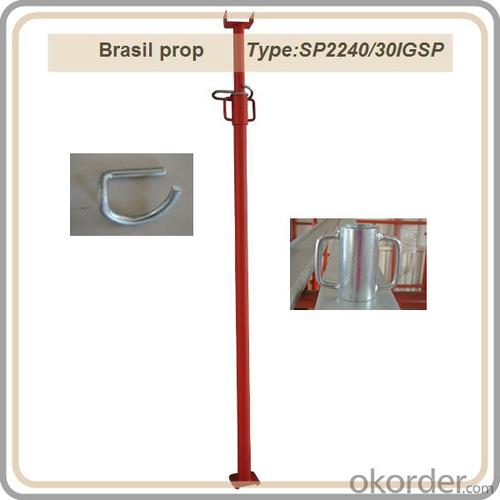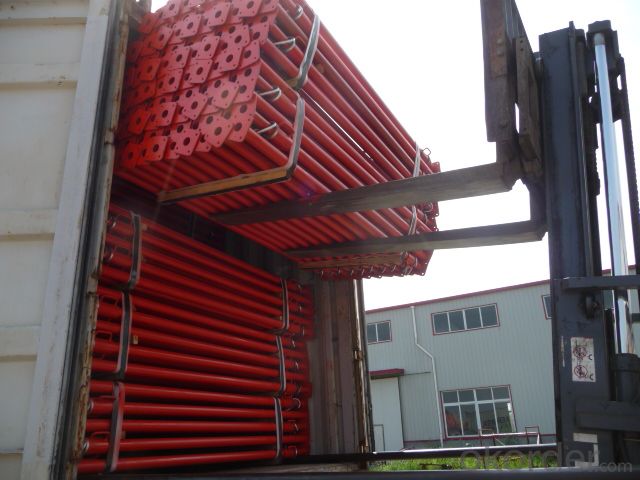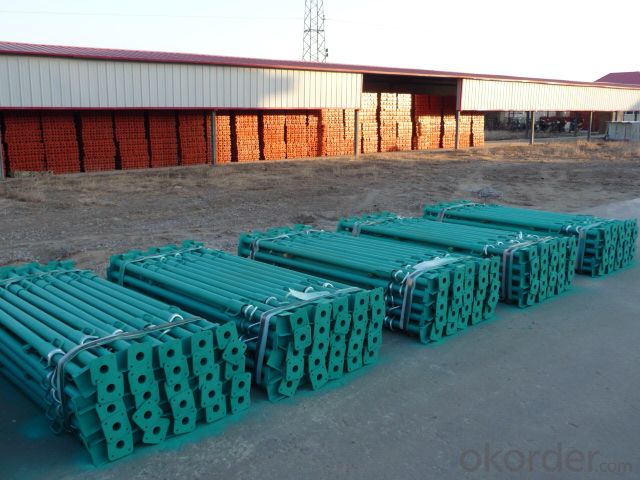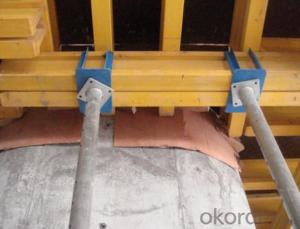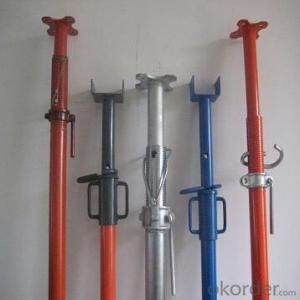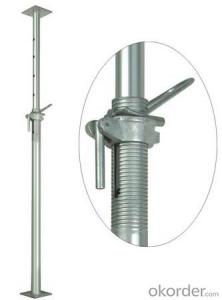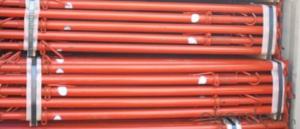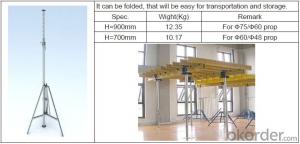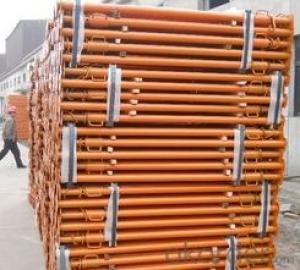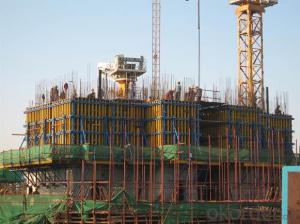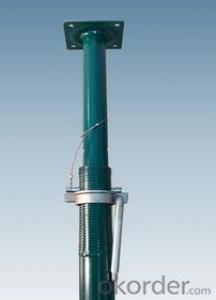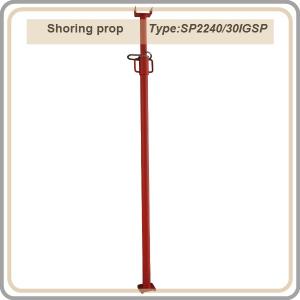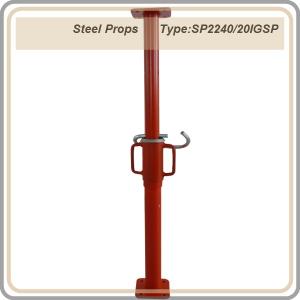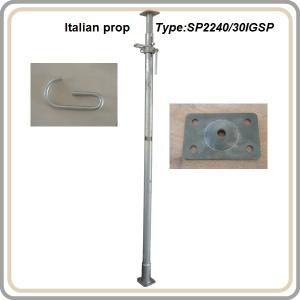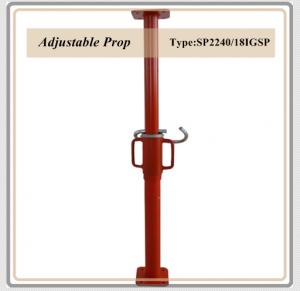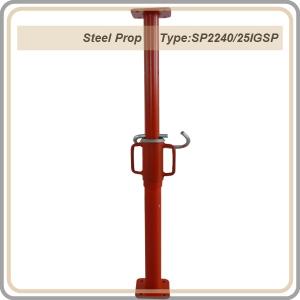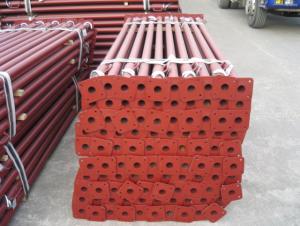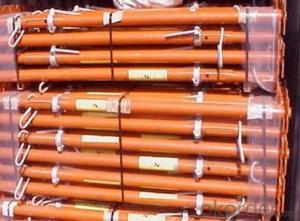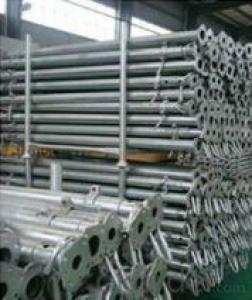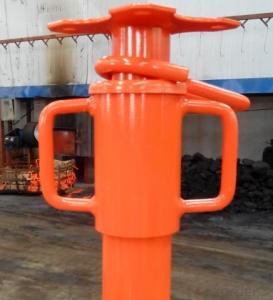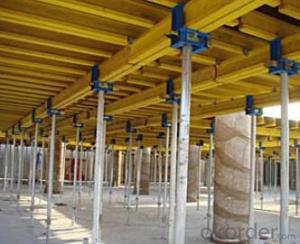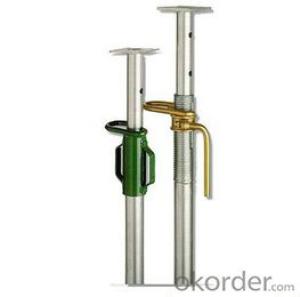Brasil prop / telescopic steel prop / red color prop 2.2-4M
- Loading Port:
- China Main Port
- Payment Terms:
- TT or LC
- Min Order Qty:
- 1680 Pieces pc
- Supply Capability:
- 10000 pc/month
OKorder Service Pledge
OKorder Financial Service
You Might Also Like
1. Length 2200-4000mm
2. Outer tube diameter 56mm
3. Inner tube diameter 48mm
4. Tube material : Q235
5. Tube thickness : 1.8mm , 2.0mm , 2.5mm . 3.0mm
6. weight : 10kgs,11kgs,12.9kgs,16.6kg
7. square plate : 120*120*4mm
8. Italian type nut
9. G-pin 12
10. Painted surface
11. Color : as customer 's request . red / blue / green / orange/ brown
Packaging & Delivery
| Packaging Details: | packaging :50pcs / bale container : 1680pcs / 20ft |
|---|---|
| Delivery Detail: | 20-30days after receive deposit |
Specifications
Adjustable props / construction prop
Height 2.2-4M
Italy type painted props
Adjustable props
Shoring props
Construction scaffold steel prop
Scaffold props
Telescopic steel props
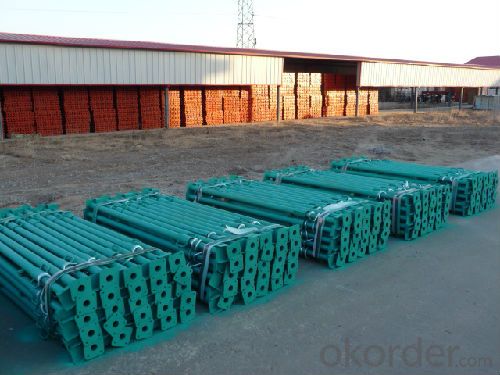
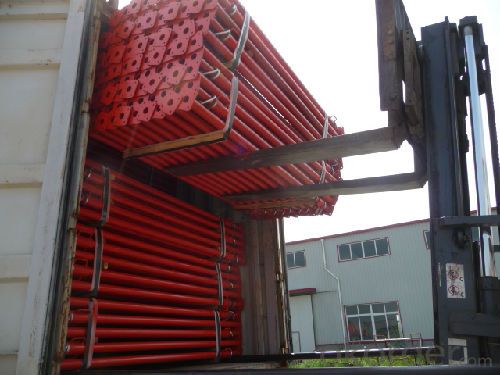
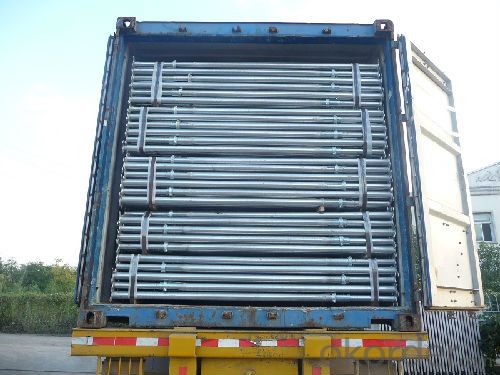
Steel Prop is a labour and time saving device to support shuttering and centering.
It is made outer tube of 60mm (O. D.) & inner pipe of 48mm (O. D.)
or outer tube 56mm (O.D.) & inner pipe 48mm (O.D.) ,
or outer tube 48mm (O.D.) & inner pipe 40 mm (O.D.) moving in each other telescopically.
The surface has painted , powder , electric galvanized and hot dipped galvanized .
The height use of props by double staging is recommended upto 7000mm only .
Top and bottom plate are provided with nail holes for wooden beam or steel beam .
The top has square shape , flower shape or U-head , U-fork head .
U-head can use fix or adjustable .
- Q: What are the common safety guidelines and regulations for using steel props?
- When using steel props, there are several common safety guidelines and regulations that need to be followed to ensure the safety of individuals and the structural stability of the props. Some of the common safety guidelines and regulations for using steel props include: 1. Proper inspection: Before using steel props, it is important to inspect them thoroughly for any signs of damage, such as cracks, bends, or corrosion. Damaged props should never be used as they may compromise safety. 2. Load capacity: Each steel prop has a specific load capacity, which should never be exceeded. It is crucial to know the load capacity of the props being used and ensure that it matches the weight being supported. Overloading the props can lead to collapsing or failure. 3. Proper installation: Steel props should be installed correctly according to the manufacturer's guidelines. This includes positioning them on a stable and level surface, ensuring the contact points are secure and level, and properly tightening any locking mechanisms. 4. Adequate bracing: When using steel props, it is important to provide adequate bracing to ensure stability. Bracing helps to prevent lateral movement and provides additional support to the props. The type and layout of bracing should be determined based on the specific requirements of the project and the structural design. 5. Stability during use: Steel props should be stable during use, with no movement or shifting. It is important to regularly check and adjust the props if any movement is observed. Additionally, any adjustments or alterations to the props should be done cautiously and in compliance with the manufacturer's guidelines. 6. Safe removal: When removing steel props, it is important to follow proper procedures to avoid any accidents or injuries. This includes gradually reducing the load on the props before removing them, ensuring that no one is standing beneath the props during removal, and storing them safely after use. 7. Regular maintenance: Regular maintenance and inspection of steel props are necessary to ensure their continued safety and effectiveness. This includes cleaning, lubricating, and inspecting them for any signs of wear or damage. Any damaged props should be repaired or replaced before further use. It is important to note that safety guidelines and regulations may vary depending on the location and specific industry. Therefore, it is crucial to consult with local authorities, industry standards, and manufacturers' instructions to ensure compliance with all applicable regulations and guidelines when using steel props.
- Q: Can steel props be used in mining applications?
- Mining applications can indeed utilize steel props. Steel props, which are alternatively referred to as steel supports or steel struts, are commonly employed in underground mining operations to furnish temporary or permanent support to the mine roof and walls. These props are constructed from top-notch steel and are engineered to endure the burdensome loads and pressures that are inherent in mining. Steel props possess adjustability and can be established at the desired height and angle to bolster the mine roof and avert collapses or cave-ins. They exhibit versatility and can be applied in diverse mining scenarios, including tunneling, shaft sinking, and longwall mining. Steel props are typically employed alongside other support systems, such as roof bolts, mesh, and shotcrete, in order to guarantee the stability and safety of the mining operation. The utilization of steel props in mining applications offers several benefits. They are robust, long-lasting, and resistant to corrosion, rendering them suitable for the rigorous and demanding conditions that are characteristic of mining environments. Steel props are also facile to install, adjust, and remove, thereby permitting efficient and adaptable support systems in mining operations. Furthermore, steel props can be reused, which reduces costs and waste that are associated with support systems in mining. All in all, steel props represent a dependable and efficacious solution for furnishing support in mining applications, thereby contributing to the safety and productivity of underground mining operations.
- Q: Can steel props be used for supporting temporary industrial structures?
- Yes, steel props can be used for supporting temporary industrial structures. Steel props are commonly used in construction and engineering projects to provide temporary support to structures such as scaffolding, formwork, and temporary roofs. They are strong, durable, and adjustable, making them suitable for supporting various types of temporary industrial structures.
- Q: Do steel props require any special certifications or inspections?
- Yes, steel props typically require special certifications and inspections to ensure their safety and compliance with industry standards. These certifications and inspections are important to guarantee that the props meet the necessary load-bearing capacity, stability, and structural integrity requirements.
- Q: Can steel props be used for supporting temporary awnings or canopies?
- Yes, steel props can be used for supporting temporary awnings or canopies. Steel props provide sturdy and reliable support, making them suitable for holding up temporary structures like awnings or canopies.
- Q: Are there any safety precautions to consider when using steel props?
- There are various safety measures to take into account when using steel props. To begin with, it is crucial to inspect the steel props thoroughly before utilization to ensure they are in good condition and devoid of any flaws or damage. Look for cracks, bends, or rust, as these can weaken the props and compromise their ability to bear loads. Should any issues be identified, the props ought to be replaced or repaired before use. Secondly, it is always important to adhere to the manufacturer's guidelines and instructions for the safe usage of steel props. This entails employing the appropriate size and type of props according to the intended load and application. Overloading the props can result in structural failure and accidents, hence strictly adhering to the recommended weight limits is crucial. Furthermore, when setting up the steel props, it is imperative to ensure proper alignment and security. This involves confirming that the props are plumb and vertical, and that the base plates are firmly fixed to prevent any movement or instability. Additionally, consider utilizing adjustable props with safety pins or locking devices to prevent unintentional height adjustments. Moreover, providing adequate support and bracing to the structure being supported by the steel props is essential. This may necessitate the use of additional beams, braces, or other supports to distribute the load and prevent any collapse or shifting. Lastly, creating a safe working environment when using steel props is of utmost importance. This includes ensuring adequate lighting, clear pathways, and keeping the area free from any obstacles or hazards that could lead to trips, slips, or falls. Workers should also receive training on the proper use and handling of the steel props and be provided with suitable personal protective equipment (PPE) such as gloves, hard hats, and safety boots. By complying with these safety precautions, the risk of accidents, injuries, and structural failures can be significantly reduced when using steel props.
- Q: Are steel props suitable for supporting formwork systems?
- Yes, steel props are suitable for supporting formwork systems. Steel props provide strong and reliable support, making them ideal for handling heavy loads and ensuring stability during the construction process. Additionally, steel props are adjustable, allowing for easy customization and efficient use in various formwork applications.
- Q: Span of 40 meters, the height of the beam to support the 1.4 meter high density?
- JDG is tightly connected to the socket of the tension steel conduit galvanized steel conduit (JDG catheter) is currently replacing the PVC pipe and other types of traditional SC electrical catheter replacement
- Q: Can steel props be used in the construction of high-speed rail lines?
- The construction of high-speed rail lines can indeed utilize steel props. In construction projects, steel props are frequently employed to provide support for a range of structures, including temporary ones like formwork and scaffolding. In the case of high-speed rail lines, steel props can be utilized to offer temporary support during the construction phase. This can involve supporting elevated sections of the track or assisting in the installation of bridges and viaducts. Steel props possess notable qualities such as strength, durability, and load-bearing capacity, rendering them suitable for managing the heavy loads and vibrations associated with high-speed rail infrastructure. Furthermore, steel props can be easily adjusted and extended to accommodate different heights and angles, making them versatile and adaptable for a variety of construction needs. All in all, the utilization of steel props in the construction of high-speed rail lines is a widespread practice that contributes to the secure and efficient development of these crucial transportation networks.
- Q: Can steel props be used for temporary support during roofing work?
- Yes, steel props can be used for temporary support during roofing work. Steel props provide strong and sturdy support, making them suitable for temporarily holding up roofing structures and ensuring the safety of workers and the integrity of the roof.
Send your message to us
Brasil prop / telescopic steel prop / red color prop 2.2-4M
- Loading Port:
- China Main Port
- Payment Terms:
- TT or LC
- Min Order Qty:
- 1680 Pieces pc
- Supply Capability:
- 10000 pc/month
OKorder Service Pledge
OKorder Financial Service
Similar products
Hot products
Hot Searches
Related keywords
